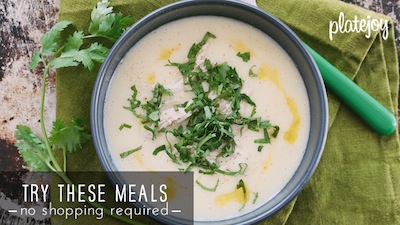Here’s my personal opinion: when you cook something from scratch, it will by any account be healthier than something you buy that is prepared. When you are cooking from start to finish, you control everything about your ingredients – their place of origin, the method of cooking, and the type of seasoning.
As a low sodium cook, I try to continually expand my culinary skills by taking cooking classes so I can make dishes (that are usually salt laden) in the comfort of my own home. I find that the more I know about the food, the more types I can eat. Sushi, Moroccan, Chinese, Mexican – all of these genres are off limits in their prepared form. But by breaking down their basic ingredients and then putting them back together (without salt) I can achieve a similar flavor with no sodium.
But while I feel confident and comfortable with cleaning, dicing, and spicing my vegetables, I have yet to really dive into my proteins. Sure, I can roast, saute, braise, and bake. I know the difference between a chop and a butt. But while I can effortlessly de-rib a handful of chard, I can not de-bone a bird. That is, until I took a butchery class at 18 Reasons last Tuesday night.
Morgan Maki, the Butcher and Charcutier at Bi-Rite Market led a one-hour class in chicken manhandling for a group of local foodies, all of us novices. After a few demonstrations – of popping the joints and cutting out the backbone – Maki put knifes in our hands and gave us the go ahead. Under careful watch, we practiced taking the birds from beast to breast, using a meat cleaver, a poultry knife, and kitchen shears to make piles of legs, thighs, and wings.
While Maki made the whole routine look effortless, it is actually a somewhat logical process of finding the bones and joints with your hands and then making the right cut. And although simply wielding a cleaver felt cool, the knowledge that I could buy a whole bird and break it down, was equally thrilling.
The importance of learning butchery, though, goes way beyond the “neat cooking tick” factor and actually has a big impact on not only healthy eating, but on a healthy environment.
“The process of butchering is so important, but often lost in the super market,” Maki says. “Buying and selling carcasses proportionally puts the least amount of stress on our producers and if I can teach people how to prepare every part of an animal, then I’m improving our chances at maintaining a healthy local economy.”
So if you are ready to get intimate with your meat, check out 18 Reasons’ calendar of upcoming classes. And check out my latest article on Examiner.com for more of Maki’s musings and how he prefers to cook his bird.
Chow on.








I love that you did this! It gives me encouragement. As a reward for working many many years at the Mental Health Center of Denver I was given an array of cookingI classes (my choice) at the Cook Street School of Fine Cooking in Denver. I am excited to dive in and only fear that I might become hooked on cooking classes! I think my first choice of classes will be Knife Skills!
OK…now you’re cooking! Love your article! For me, the biggest (huge actually!)benefit of cutting up the whole chicken is the left over bones. Sometimes I save them in the freezer ’till I have enough to make a large amount of stock…sometimes I just use the one chicken. A large stock pot full can be reduced to a glittering jewel of concentrated chicken flavor. In it’s pure gelatinous form you only need to cut off a small amount…add it to any sauce and get an instant flavor boost. Best of all…no salt…tons of flavor…all natural…foodie gold!